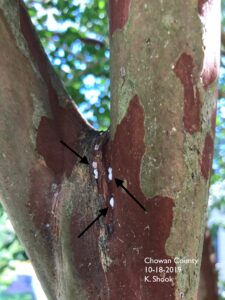Crape Myrtle Bark Scale Continues to Affect Local Trees
go.ncsu.edu/readext?927347
en Español / em Português
El inglés es el idioma de control de esta página. En la medida en que haya algún conflicto entre la traducción al inglés y la traducción, el inglés prevalece.
Al hacer clic en el enlace de traducción se activa un servicio de traducción gratuito para convertir la página al español. Al igual que con cualquier traducción por Internet, la conversión no es sensible al contexto y puede que no traduzca el texto en su significado original. NC State Extension no garantiza la exactitud del texto traducido. Por favor, tenga en cuenta que algunas aplicaciones y/o servicios pueden no funcionar como se espera cuando se traducen.
Português
Inglês é o idioma de controle desta página. Na medida que haja algum conflito entre o texto original em Inglês e a tradução, o Inglês prevalece.
Ao clicar no link de tradução, um serviço gratuito de tradução será ativado para converter a página para o Português. Como em qualquer tradução pela internet, a conversão não é sensivel ao contexto e pode não ocorrer a tradução para o significado orginal. O serviço de Extensão da Carolina do Norte (NC State Extension) não garante a exatidão do texto traduzido. Por favor, observe que algumas funções ou serviços podem não funcionar como esperado após a tradução.
English
English is the controlling language of this page. To the extent there is any conflict between the English text and the translation, English controls.
Clicking on the translation link activates a free translation service to convert the page to Spanish. As with any Internet translation, the conversion is not context-sensitive and may not translate the text to its original meaning. NC State Extension does not guarantee the accuracy of the translated text. Please note that some applications and/or services may not function as expected when translated.
Collapse ▲ First observed locally in 2019, crape myrtle bark scale is an insect that affects crape myrtle trees. It is often noticed because of the black sooty mold that covers infected trees. However, the problem begins with the insect. CMBS are very small, resembling grains of rice; they are frequently found attached to the bark and sometimes leaves of trees. As they feed, the insects produce a sticky waste-product that covers the tree, and eventually turns the tree black. In addition to being unsightly, the sooty mold can reduce the health and performance of infected trees. To remove the sooty mold, and improve the health of trees, homeowners must first control the insect. Below is an integrated pest management approach for home landscapes:
First observed locally in 2019, crape myrtle bark scale is an insect that affects crape myrtle trees. It is often noticed because of the black sooty mold that covers infected trees. However, the problem begins with the insect. CMBS are very small, resembling grains of rice; they are frequently found attached to the bark and sometimes leaves of trees. As they feed, the insects produce a sticky waste-product that covers the tree, and eventually turns the tree black. In addition to being unsightly, the sooty mold can reduce the health and performance of infected trees. To remove the sooty mold, and improve the health of trees, homeowners must first control the insect. Below is an integrated pest management approach for home landscapes:
- Prevention. Avoid infestation by creating a diverse landscape. Use a variety of plants, including native alternatives. For suggestions, visit <plants.ces.ncsu.edu>.
- Cultural control. Keep plants healthy. Avoid heavy pruning, and water during times of drought. Insects are often attracted to stressed plants.
- Mechanical/Physical control. Insects can be removed by scrubbing with a brush and soapy water. Although difficult, it is a great organic option.
- Biological control. Scout infected trees. Become familiar with ladybugs, a natural predator, and their life cycles (hint: infant ladybugs do not look like adult ladybugs!). Keep in mind that controls may also harm natural predators.
- Chemical control. Horticulture oils can be applied year round; follow all label directions. Systemic products can be drenched around infected trees, but because these products may also harm pollinators, take extra precaution by avoiding application near bloom, and by following all label directions.



